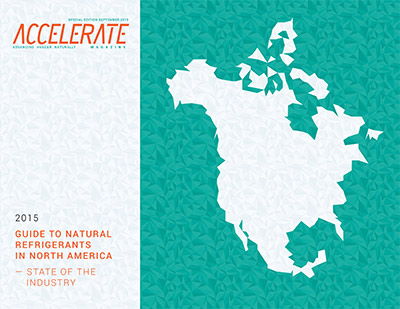Guide charts rise of naturals
20th September 2015 BELGIUM: The latest market guide from Shecco charts the rise of natural refrigerants in North America, particularly CO2.
BELGIUM: The latest market guide from Shecco charts the rise of natural refrigerants in North America, particularly CO2.
North America has always been a large user of ammonia, and a number of hydrocarbons have also recently been accepted for the first time on the US EPA’s SNAP register, but it is in the area of CO2 where the USA is making the most progress.
Two years on from the last North American survey, the new 160-page guide is designed to provide an insight into the policy and technological trends that are shaping the future of the increasingly dynamic North American market.
Shecco reports that during the time that has elapsed since its last guide to natural refrigerants in North America in 2013, the north American market has gone from strength to strength.
The strengthening of policy has come in various forms, including approvals of new substances and delistings of high GWP refrigerants by the US EPA, increasingly stringent in energy efficiency standards, and the continuing global HCFC phaseout.
In 2013, when the first guide was published, North America was most often placed in a distant third place by Shecco behind Europe and Japan in terms of the variety of applications utilising natural refrigerants. Commercial and industrial refrigeration applications using natural refrigerants are said to have experienced triple-digit growth since 2013.
Transcritical CO2 is a growing trend in commercial applications in Canada. Sobeys, Canada’s second largest food retailer with 1,778 stores, has 15-20 stores being opened annually that will use CO2 transcritical systems on top of the 78 they already have.
The USA has also seen impressive growth, currently boasting 52 CO2 transcritical stores, and Shecco pinpoints new technologies available to allow for the proliferation of transcritical solutions in the warmer south.
Industrial refrigeration was where North America already had an established market for natural refrigerants, and this trend has continued since 2013, with the total square footage of North America’s cold storage amounting to 2.81 billion, over half of the world total of 4.73 billion cubic feet.
Quebec is said to have the highest concentration of transcritical co2 systems in both commercial and industrial sizes, as well as the highest number of low-charge ammonia systems in North America. Alongside Quebec’s 94 CO2 transcritical stores, there are said to be over 90 “next generation” industrial refrigeration installations. These include 56 low-charge ammonia installations, 34 CO2 transcritical systems and 5 CO2/NH3 secondary systems.
The availability of incentives for companies to use energy efficient systems has impacted on natural refrigerant sales in the province. The Refrigeration Optimisation Programme (OPTER) supported the adoption of measures to improve energy efficiency, together with the conversion/replacement of refrigeration equipment to low-GWP technologies, in over 130 installations (mainly supermarkets, warehouses, arenas and the food industry) between 2008-2013.
In highlighting the dynamic shifts taking place in North America, Nina Masson, Shecco’s deputy managing director and the publication’s lead author said: “The North American market continues to be one of the most responsive and encouraging markets for natural refrigerants. Our second publication is all the more pleasing because we can see that in many respects North America is a world leader in the use of natural refrigerants in industrial refrigeration and is pushing boundaries through its continual innovation.
The GUIDE North America is now available to download for free from the Shecco website.







